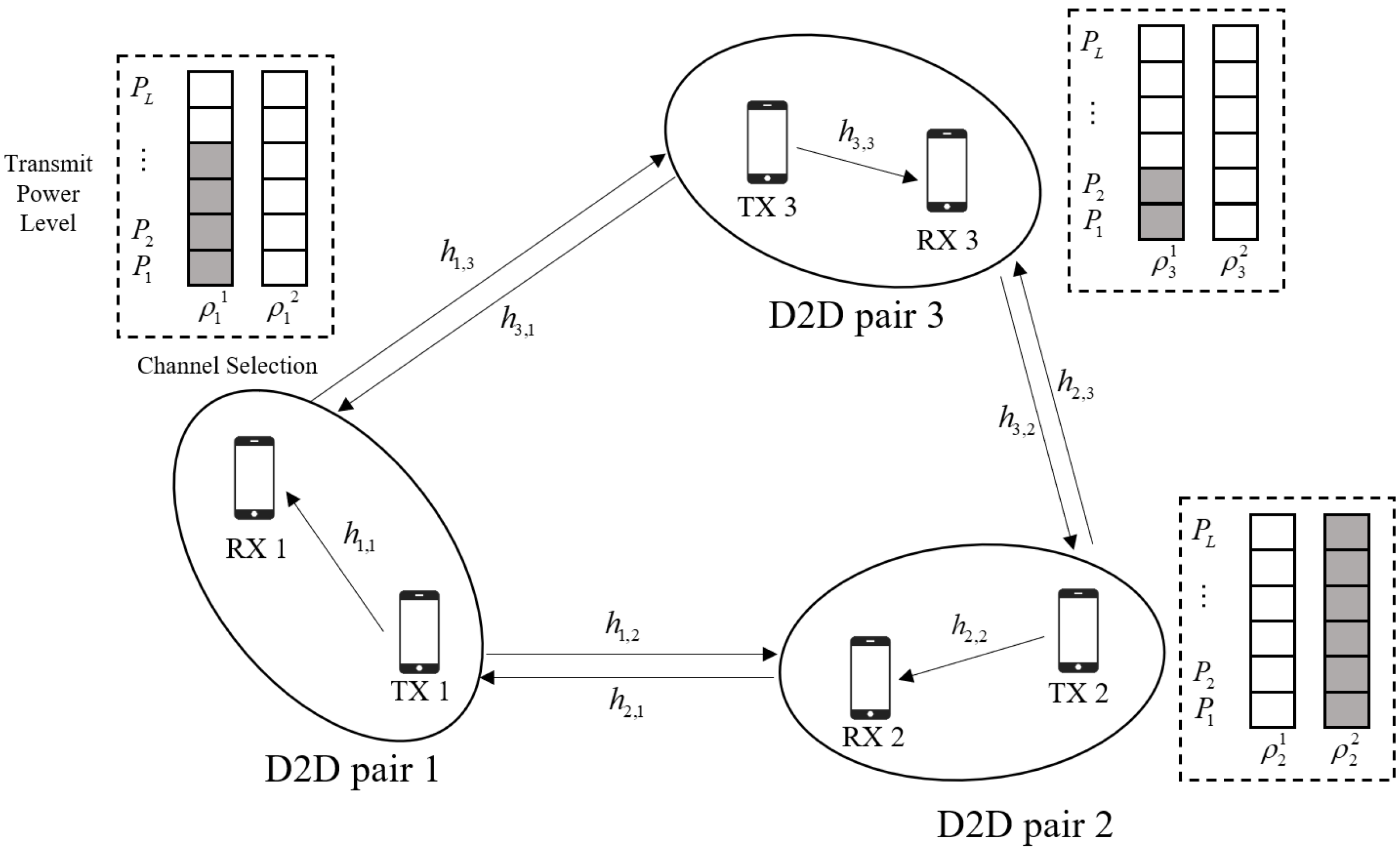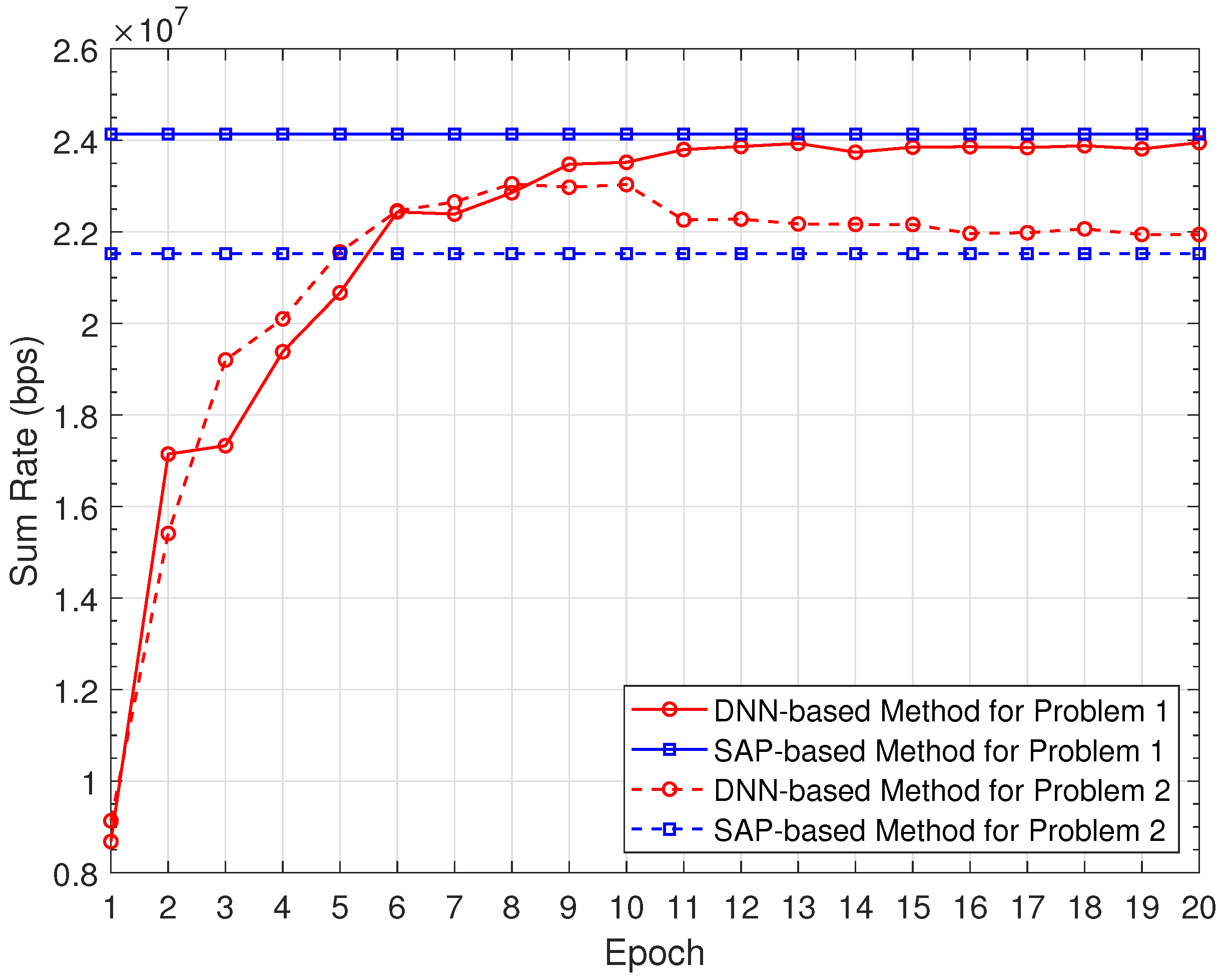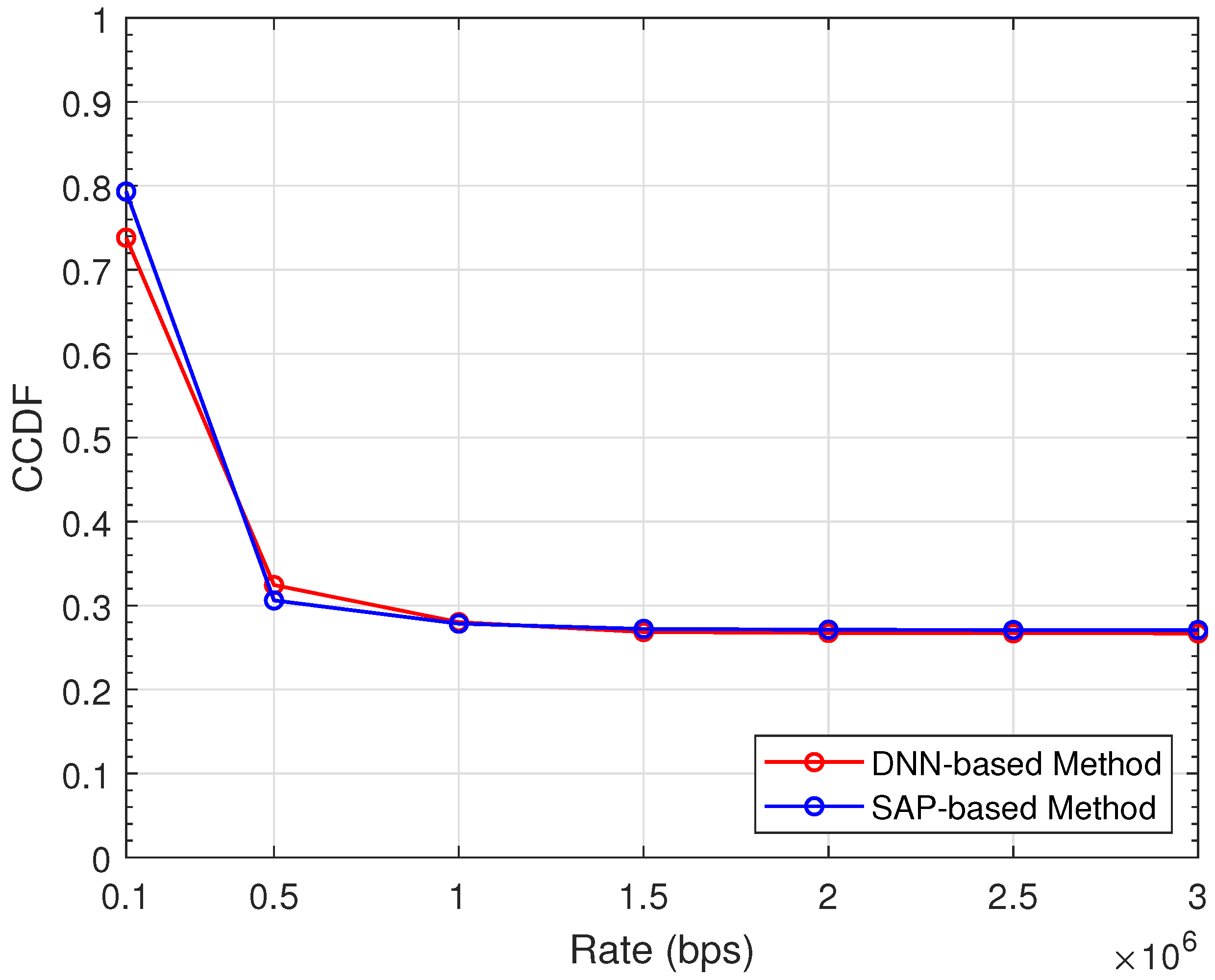Deep-Learning-Based Resource Allocation for Time-Sensitive Device-to-Device Networks
Abstract
:1. Introduction
1.1. Related Works
1.2. Motivation and Contribution
- Instead of Shannon rate, we adopt the short packet coding rate to more accurately capture the rate loss in the finite blocklength regime. The reliability of D2D transmissions is guaranteed by choosing a proper coding rate lower than the achievable rate.
- We propose an iterative channel selection and power allocation algorithm based on game theory. The sum utility function of all D2D pairs is maximized by alternately updating the channel selection and power allocation of each D2D pair.
- To improve the time efficiency of the resource allocation procedure, we propose two DNN-based methods to solve the sum rate maximization problems with and without the minimum rate constraint, respectively. The network structure and output are properly designed to improve the learning ability of the network.
2. System Model and Problem Formulation
2.1. System Model and Transmission Model
2.2. Problem Formulation
3. Game Theory-Based Resource Allocation
| Algorithm 1 SAP-Based Channel Selection and Power Allocation Algorithm |
|
4. Deep Learning Based Resource Allocation
4.1. Basic DNN Module
4.2. DNN Model for Resource Allocation
4.3. DNN Model for Resource Allocation with Minimum Rate Constraint
5. Simulation Results
6. Conclusions
Author Contributions
Funding
Institutional Review Board Statement
Informed Consent Statement
Data Availability Statement
Conflicts of Interest
References
- Zhang, S.; Xu, X.; Wu, Y.; Lu, L. 5G: Towards energy-efficient, low-latency and high-reliable communications networks. In Proceedings of the 2014 IEEE International Conference on Communication Systems, Macau, China, 19–21 November 2014; pp. 197–201. [Google Scholar]
- Chen, H.; Abbas, R.; Cheng, P.; Shirvanimoghaddam, M.; Hardjawana, W.; Bao, W.; Li, Y.; Vucetic, B. Ultra-reliable low latency cellular networks: Use cases, challenges and approaches. IEEE Commun. Mag. 2018, 56, 119–125. [Google Scholar] [CrossRef] [Green Version]
- Parvez, I.; Rahmati, A.; Guvenc, I.; Sarwat, A.I.; Dai, H. A survey on low latency towards 5G: RAN, core network and caching solutions. IEEE Commun. Surveys Tuts. 2018, 20, 3098–3130. [Google Scholar] [CrossRef]
- Service Requirements for Cyber-Physical Control Applications in Vertical Domains, Document TS 22.104; Version 18.2.0; 3rd Generation Partnership Project (3GPP); 2021.
- Soret, B.; Mogensen, P.; Pedersen, K.I.; Aguayo-Torres, M.C. Fundamental tradeoffs among reliability, latency and throughput in cellular networks. In Proceedings of the 2014 IEEE Globecom Workshops (GC Wkshps), Austin, TX, USA, 8–12 December 2014; pp. 1391–1396. [Google Scholar]
- Tehrani, M.N.; Uysal, M.; Yanikomeroglu, H. Device-to-device communication in 5G cellular networks: Challenges, solutions, and future directions. IEEE Commun. Mag. 2014, 52, 86–92. [Google Scholar] [CrossRef]
- Asadi, A.; Wang, Q.; Mancuso, V. A survey on device-to-device communication in cellular networks. IEEE Commun. Surveys Tuts. 2014, 16, 1801–1819. [Google Scholar] [CrossRef] [Green Version]
- Yu, G.; Xu, L.; Feng, D.; Yin, R.; Li, G.Y.; Jiang, Y. Joint mode selection and resource allocation for device-to-device communications. IEEE Trans. Commun. 2014, 62, 3814–3824. [Google Scholar] [CrossRef]
- Jiang, Y.; Liu, Q.; Zheng, F.; Gao, X.; You, X. Energy-efficient joint resource allocation and power control for D2D communications. IEEE Trans. Veh. Technol. 2016, 65, 6119–6127. [Google Scholar] [CrossRef] [Green Version]
- Dai, J.; Liu, J.; Shi, Y.; Zhang, S.; Ma, J. Analytical modeling of resource allocation in D2D overlaying multihop multichannel uplink cellular networks. IEEE Trans. Veh. Technol. 2017, 66, 6633–6644. [Google Scholar] [CrossRef]
- Ma, R.; Xia, N.; Chen, H.; Chiu, C.; Yang, C. Mode selection, radio resource allocation, and power coordination in D2D communications. IEEE Wireless Commun. 2017, 24, 112–121. [Google Scholar] [CrossRef]
- Zhou, Z.; Ota, K.; Dong, M.; Xu, C. Energy-efficient matching for resource allocation in D2D enabled cellular networks. IEEE Trans. Veh. Technol. 2017, 66, 5256–5268. [Google Scholar] [CrossRef] [Green Version]
- Lyu, J.; Chew, Y.H.; Wong, W.C. A stackelberg game model for overlay D2D transmission with heterogeneous rate requirements. IEEE Trans. Veh. Technol. 2016, 65, 8461–8475. [Google Scholar] [CrossRef] [Green Version]
- Chu, Z.; Yu, W.; Xiao, P.; Zhou, F.; Al-Dhahir, N.; Ul, Quddus, A.; Tafazolli, R. Opportunistic spectrum sharing for D2D-based URLLC. IEEE Trans. Veh. Technol. 2019, 68, 8995–9006. [Google Scholar] [CrossRef]
- Wu, Y.; Wu, D.; Ao, L.; Yang, L.; Fu, Q. Contention-based radio resource management for URLLC-oriented D2D communications. IEEE Trans. Veh. Technol. 2020, 69, 9960–9971. [Google Scholar] [CrossRef]
- Wu, Y.; Wu, D.; Yue, C.; Yang, Y. Joint Reservation and Contention-Based Access for URLLC-Enabled D2D Communications. IEEE Commun. Lett. 2021, 26, 212–216. [Google Scholar] [CrossRef]
- Liu, L.; Yu, W. A D2D-Based Protocol for Ultra-Reliable Wireless Communications for Industrial Automation. IEEE Trans. Wireless Commun. 2018, 17, 5045–5058. [Google Scholar] [CrossRef]
- Yuan, Y.; Yang, T.; Hu, Y.; Feng, H.; Hu, B. Two-Timescale Resource Allocation for Cooperative D2D Communication: A Matching Game Approach. IEEE Trans. Veh. Technol. 2021, 70, 543–557. [Google Scholar] [CrossRef]
- Lee, M.; Xiong, Y.; Yu, G.; Li, G.Y. Deep neural networks for linear sum assignment problems. IEEE Wireless Commun. Lett. 2018, 7, 962–965. [Google Scholar] [CrossRef]
- Zappone, A.; Sanguinetti, L.; Debbah, M. User association and load balancing for massive MIMO through deep learning. In Proceedings of the 2018 52nd Asilomar Conference on Signals, Systems, and Computers, Pacific Grove, CA, USA, 28–31 October 2018; pp. 1262–1266. [Google Scholar]
- Gao, J.; Hu, M.; Zhong, C.; Li, G.; Zhang, Z. An attention-aided deep learning framework for massive MIMO channel estimation. IEEE Trans. Wireless Commun. 2021. early access. [Google Scholar] [CrossRef]
- Qin, Z.; Ye, H.; Li, G.Y.; Juang, B.F. Deep learning in physical layer communications. IEEE Wireless Commun. 2019, 26, 93–99. [Google Scholar] [CrossRef] [Green Version]
- Lee, W. Resource allocation for multi-channel underlay cognitive radio network based on deep neural network. IEEE Commun. Lett. 2018, 22, 1942–1945. [Google Scholar] [CrossRef]
- Tan, J.; Liang, Y.C.; Zhang, L.; Feng, G. Deep reinforcement learning for joint channel selection and power control in D2D networks. IEEE Trans. Wireless Commun. 2021, 20, 1363–1378. [Google Scholar] [CrossRef]
- Polyanskiy, Y.; Poor, H.V.; Verdu, S. Channel coding rate in the finite blocklength regime. IEEE Trans. Inf. Theory 2010, 56, 2307–2359. [Google Scholar] [CrossRef]
- Schiessl, S.; Gross, J.; Al-Zubaidy, H. Delay analysis for wireless fading channels with finite blocklength channel coding. In Proceedings of the 18th ACM International Conference on Modeling, Analysis and Simulation of Wireless and Mobile Systems, New York, NY, USA, 2 November 2015; pp. 13–22. [Google Scholar]
- Hornik, K.; Stinchcombe, M.; White, H. Multilayer feedforward networks are universal approximators. Neural Netw. 1989, 2, 359–366. [Google Scholar] [CrossRef]






| Parameter | Value |
|---|---|
| Number of D2D pairs, N | 10 |
| Number of channels, K | 2,4,5,6,7 |
| Channel bandwidth, B | 180 KHz |
| Slot length, T | 1 ms |
| Maximum transmit power, | 23 dBm |
| Power spectral density of noise, | −174 dBm/Hz |
| Reliability constraint, | |
| Minimum rate, | bps |
| Initial exploration probability | 0.5 |
| Decay rate w | 0.9 |
| Algorithm | Sum Rate of 1 | Sum Rate of 2 | Rate Excess Probability of 2 |
|---|---|---|---|
| DNN-based Method | 23.84 Mbps | 21.90 Mbps | 0.7382 |
| SAP-based Method | 24.32 Mbps | 21.52 Mbps | 0.7903 |
Publisher’s Note: MDPI stays neutral with regard to jurisdictional claims in published maps and institutional affiliations. |
© 2022 by the authors. Licensee MDPI, Basel, Switzerland. This article is an open access article distributed under the terms and conditions of the Creative Commons Attribution (CC BY) license (https://creativecommons.org/licenses/by/4.0/).
Share and Cite
Zheng, Z.; Chi, Y.; Ding, G.; Yu, G. Deep-Learning-Based Resource Allocation for Time-Sensitive Device-to-Device Networks. Sensors 2022, 22, 1551. https://doi.org/10.3390/s22041551
Zheng Z, Chi Y, Ding G, Yu G. Deep-Learning-Based Resource Allocation for Time-Sensitive Device-to-Device Networks. Sensors. 2022; 22(4):1551. https://doi.org/10.3390/s22041551
Chicago/Turabian StyleZheng, Zhe, Yingying Chi, Guangyao Ding, and Guanding Yu. 2022. "Deep-Learning-Based Resource Allocation for Time-Sensitive Device-to-Device Networks" Sensors 22, no. 4: 1551. https://doi.org/10.3390/s22041551
APA StyleZheng, Z., Chi, Y., Ding, G., & Yu, G. (2022). Deep-Learning-Based Resource Allocation for Time-Sensitive Device-to-Device Networks. Sensors, 22(4), 1551. https://doi.org/10.3390/s22041551







